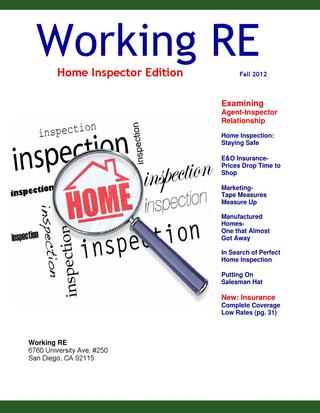
|
Home Inspectors Edition | Circulation 22,000 | Advertise | Subscribe | |
Published by OREP, E&O Insurance Experts | November 2012 |

|
>
Click to Print
>
Approved Continuing Education at Discount |
Setting reasonable expectations about a home inspection report is more than
half the battle in avoiding liablity problems.
~If you
haven't already, take a look at Working RE's new
Home Inspector Edition.
Editor’s
Note:
The following is intended for
your clients because, as most seasoned inspectors will tell you,
setting reasonable expectations about a home inspection report is more
than half the battle in avoiding liability problems.
Best Way to Handle Complaints?
Anticipate Them
By Alan Carson, Carson Dunlop & Associates Ltd.
One of the best ways to handle complaints is to anticipate them. We
include a document called
When
Things Go Wrong in our reports.
We remind clients of this document when complaints come in. It is nice
to be able to say, ‘We told you this would happen.’ Feel free to use
all or part of this document.
Intermittent or Concealed Problems
Some problems can only be discovered by
living in a house. They cannot be discovered during the few hours of a
home inspection. For example, some shower stalls leak when people are
in the shower, but do not leak when you simply turn on the tap. Some
roofs and basements only leak when specific conditions exist. Some
problems will only be discovered when carpets are lifted, furniture is
moved or finishes are removed.
No Clues
These problems may have existed at the time
of the inspection but there were no clues as to their existence. Our
inspections are based on the past performance of the house. If there
are no clues of a past problem, it is unfair to assume we should
foresee a future problem.
We
Always Miss Some Minor Things
Some say we are inconsistent because our
reports identify some minor problems but not others. The minor
problems that are identified were discovered while looking for more
significant problems. We note them simply as a courtesy. The intent of
the inspection is not to find the $200 problems; it is to find the
$2,000 problems. These are the things that affect people’s decisions
to purchase.
Contractors’ Advice
A common source of dissatisfaction with home inspectors comes from
comments made by contractors. Contractors’ opinions often differ from
ours. Don’t be surprised when three roofers all say the roof needs
replacement when we said that the roof would last a few more years
with some minor repairs.
(story continues below)

(story continues)
Last Man in Theory
Most Recent Advice Is Best
There is more to the Last Man in
Theory. It suggests that it is human nature for homeowners to
believe the last bit of “expert” advice they receive, even if it is
contrary to previous advice. As home inspectors, we unfortunately find
ourselves in the position of “first man In” and consequently it is our
advice that is often disbelieved.
Why Didn’t We See It
Contractors may say, “I can’t believe you had this house inspected, and
they didn’t find this problem.” There are several reasons for these
apparent oversights:
Conditions During Inspection
The Wisdom of Hindsight
A Long Look
3. If we spent half an hour under the kitchen sink or 45 minutes
disassembling the furnace, we’d find more problems too. Unfortunately,
the inspection would take several days and would cost considerably more.
We’re Generalists
4. We are generalists, we are not specialists. The heating contractor
may indeed have more heating expertise than we do. This is because we
are expected to have heating expertise and plumbing expertise,
structural expertise, electrical expertise, et cetera.
Invasive Look
5. Problems often become apparent when carpets or plaster are removed,
when fixtures or cabinets are pulled out, and so on. A home inspection
is a visual examination. We don’t perform any invasive or destructive
tests.
Not Insurance
In conclusion, a home inspection is designed to better your odds. It is
not designed to eliminate all risk. For that reason, a home inspection
should not be considered an insurance policy. The premium that an
insurance company would have to charge for a policy with no deductible,
no limit and an indefinite policy period would be considerably more than
the fee we charge. It would also not include the value added by the
inspection.
We hope this is food for thought.
About the Author
Alan Carson is Past President of the American Society of Home Inspectors (ASHI)
and principal in Carson Dunlop, one of Canada’s largest home inspection
firms, founded in 1978. Carson Dunlop is distributors of the
ASHI@HOME training program home study,
Horizon report writing and business management system, the Home
Reference Book and Technical Reference Guide, which identifies the age
and size of HVAC equipment.
ATTENTION: You are receiving WRE Online News because you opted in at WorkingRE.com or purchased E&O insurance from OREP. WRE Online News Edition provides news-oriented content twice a month. The content for WRE Special Offer Editions is provided by paid sponsors. If you no longer wish to receive these emails from Working RE, please use the link found at the bottom of this newsletter to be removed from our mailing list.



